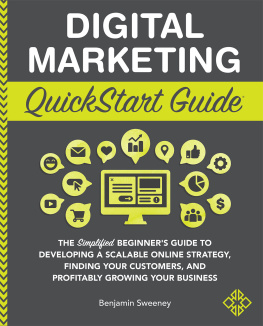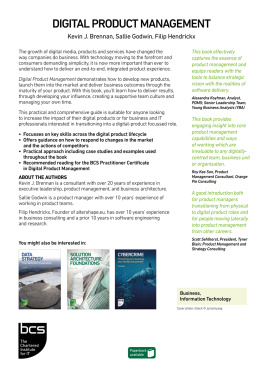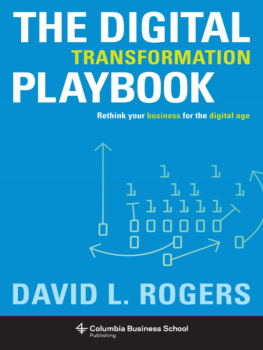
The Ultimate Field Guide to
Digital Program Management
By Daniel Newman and Olivier Blanchard
No portion of this publication may be reproduced, stored in any electronic system or transmitted in any form or by any means, electronic, mechanical, photocopy, recording or otherwise, without written permission from the authors. Brief quotations may be used in literary reviews.
2015 Daniel Newman and Olivier Blanchard. All rights reserved.
Contact us at www.ultimatefieldguides.com for university or bulk orders.
Cover Art Photography by Olivier Blanchard
ISBN: 978-194327573-1
First Printing 2015
Publisher
Broadsuite, Inc.
T: 817-480-3038
www.broadsuite.com
Table of Contents
Building the foundations of your digital practice
Step 1: Start with business goals
The most common flaw of digital practice is that their activities dont ultimately drive concrete business outcomes. Digital practices too often focus on driving digital outcomes only: more visits to a website, more mentions of the brand, more likes and shares on social channels, and so on. This isnt to say that the above are in any way unimportant. Digital outcomes like these have value they have their role to play but they are not, in and of themselves, primary business objectives. They are intermediate business objectives, secondary business objectives. But any digital practice that aims to drive secondary business objectives and not primary business objectives will always fall short of expectations.
Before an organization gets ahead of itself with strategy and tactics, it needs to start at the beginning. It needs to start with purpose and value , with basic questions about what a digital practice should drive. To do that, it needs to cast assumptions aside and make sure it asks the right questions.
The beginning then, the starting point, is not what should we do on digital channels? It is not how should we use email and Twitter and LinkedIn? Those questions come later. Companies that start here skip a crucial step in the planning process. The beginning has nothing to do with digital channels. The beginning focuses entirely on the business, and it is simply this: What needles are we trying to move in the next year? What business objectives are we, as a company, focused on? Borrowing from WOM (word-of-mouth) pioneer Brains on Fire s famous question: What will you be celebrating in six months?

This is where it startsnot with channels, tactics, tips and tricks, editorial schedules, or even content calendars. It starts with understanding the companys objectives and desired outcomes. When companies remember to start with this step, their digital practices tend to drive these objectives. When companies skip that step, their digital practices tend to drive likes and website visits. Simple enough, but most companies sabotage themselves before they invest their first penny in their digital efforts simply by not focusing on the right objectives.
Step 2: Turn goals into targets
On the plus side, setting goals, outlining objectives and identifying targets are fairly mainstream business management tasks. You dont need to know how to use Twitter to do any of it. You dont need a digital expert or a social media strategist in the room. Every CEO should be able to come up with a company-wide set of goals for the coming year (and beyond), and every executive and department head should be able to provide their own group-specific versions.
For the CEO, these goals may simply boil down to: 14 percent YOY ( year over year revenue) growth.
Some CEOs dont bother to be that specific. You will occasionally run into a CEO whose idea of direction is simply sell more stuff. (You have probably bumped into one or two by now.) In their defense, there is something to be said for keeping things simple. In the absence of clear targets, you can just assume that, at a minimum, you want to beat last years numbers. In the presence of a specific target though, the challenge is to determine how to reach it.

Whether the company is 10,000 or 10 employees strong, the process is the same: every department has a role to play in the companys growth. Every business function has to come up with its own wedge in that growth pie. Sales and Business Development are going to have to take the lead, since they are the primary drivers of revenue. Other functions (Marketing, Customer Service, Product Management, etc.) need to give some thought to how they will help drive growth in two specific ways:
1. How will they drive growth within the framework of their own specific function?
2.-How will they drive growth in support of Sales and Business Development?
To keep the exercise simple, draw a line down a blank sheet of paper. The left column will refer to Item 1. The right column will refer to Item 2. As an example, here is what a Customer Services basic contribution to the companys 14 percent YOY plan should look like:

Step 3: Create a complete roadmap
In a way, once leadership sets the overall company objectives, the process of devising a plana roadmaptoward achieving those objectives starts with a simple question: How can I do a better job of contributing to that goal? This is a different type of approach from the old giving it 110 percent motto. The idea isnt to just work harder, its actually to work smarter. It doesnt mean you wont have to work hard, but a company has a much greater chance of success if everyone gives a little thought to how their energy is best applied to key common goals.

To come back to our Customer Service example, list No. 1 is fairly straightforward: increasing positive resolutions, improving resolution times and follow-ups these are good things. The impact on the company can only be positive, and some results may even be measurable, but it has little tangible value to the companys overall 14 percent YOY growth objective. These types of outcomes tend to get lost in the shuffle when they are reported monthly or quarterly. One reason is that they are disconnected from the overall targets. This is why most companies still think of Customer Service as a cost center. (Look at trending on Customer Service budgets over the years and you will understand how most companies perceive the function.)
List No. 2, however, paints a different picture of the Customer Service departments value to the organization. Take the first item, for instance:
Decrease customer erosion by 50 percent.
Lets say the companys customer erosion rate is 10 percent per year. (The company loses 10 percent of its transacting customers every year.) And lets say that, on average, this customer erosion costs the company $10 million per year. Reducing customer retention by 50 percent means Customer Service would rescue $5 million worth of revenue in the next year alone. Thats a $5 million contribution to a $100 million business. Not too shabby. This is how a Customer Service department goes from being seen as a mere cost center (and, far too often, a necessary evil ) to becoming a key link in the profit center chain.
Next page













